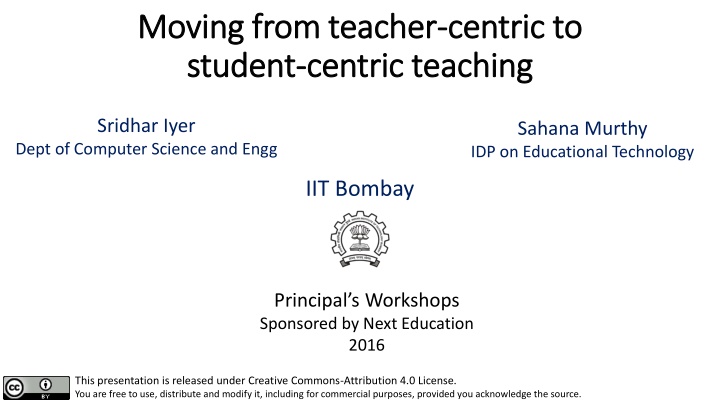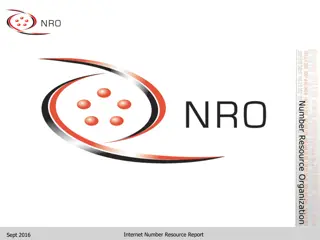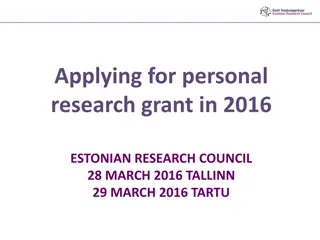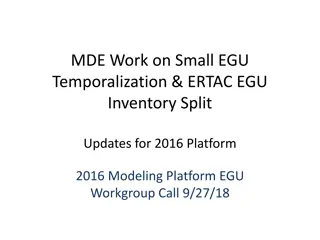
Transitioning to Student-Centric Teaching Methods at IIT Bombay
Explore how the Department of Computer Science and Engineering at IIT Bombay shifted from teacher-centric to student-centric teaching approaches under the guidance of Sridhar Iyer and Sahana Murthy. Discover practical strategies and goals set during the Principal's Workshops sponsored by Next Education in 2016. Enhance your understanding of effective learning activities, the importance of practice, and the debate between traditional lectures and interactive learning experiences.
Download Presentation

Please find below an Image/Link to download the presentation.
The content on the website is provided AS IS for your information and personal use only. It may not be sold, licensed, or shared on other websites without obtaining consent from the author. If you encounter any issues during the download, it is possible that the publisher has removed the file from their server.
You are allowed to download the files provided on this website for personal or commercial use, subject to the condition that they are used lawfully. All files are the property of their respective owners.
The content on the website is provided AS IS for your information and personal use only. It may not be sold, licensed, or shared on other websites without obtaining consent from the author.
E N D
Presentation Transcript
Moving from teacher Moving from teacher- -centric to student student- -centric teaching centric teaching centric to Sridhar Iyer Sahana Murthy IDP on Educational Technology Dept of Computer Science and Engg IIT Bombay Principal s Workshops Sponsored by Next Education 2016 This presentation is released under Creative Commons-Attribution 4.0 License. You are free to use, distribute and modify it, including for commercial purposes, provided you acknowledge the source.
A little bit about you A little bit about you I teach 1) English 2) Maths 3) Science 4) Social Studies 5) Computers 6) Pre-primary 7) Other IIT Bombay Principal's Workshops, Next Education - 2016 2
Warm up Warm up Think of one activity that you feel you excel at doing. Write down your answer. You need not share this with anyone! Think about why you are so good at this activity. Write down the top 3 reasons for your mastery in this activity. Let me guess - One of your top 3 reasons is likely to be: Practice. Experience IIT Bombay Principal's Workshops, Next Education - 2016 3
Practice Practice Again, think of the activity that you feel you excel at doing. Do you feel that you could have gained such mastery by listening to lectures on the topic? Point to keep in mind: As learners, we develop mastery through practice (doing activities, rather than simply listening to lectures, or watching demos). So, As teachers, we must ensure that we provide our students with practice sufficient and timely opportunities. Principal's Workshops, Next Education - 2016 IIT Bombay 4
Workshop Goals Workshop Goals In this workshop you will: Experience some research-based strategies for improving learning. Design some effective learning activities for your class. Share some best-practices from your school. IIT Bombay Principal's Workshops, Next Education - 2016 5
Debate Debate Consider two teachers A and B. Teacher A gives an excellent lecture in the class, demonstrates solving many problems, and gives appropriate homework to her students. Teacher B does not lecture continuously nor does she give as much homework. Instead, she makes her students do activities in class, that lets them practice what they have learned immediately, and ensures that they get feedback on their work. Form two groups. GROUP A Write points for when Teacher A s methods are better. GROUP B Write points for when Teacher B s methods are better. IIT Bombay Principal's Workshops, Next Education - 2016 6
Debate (Teacher A vs Teacher B) Debate (Teacher A vs Teacher B) * Audience responses Let s summarize. IIT Bombay Principal's Workshops, Next Education - 2016 7
20th th Century Teacher Century Teacher A A - - 20 Teacher A gives an excellent lecture in the class, demonstrates solving many problems, and gives appropriate homework to her students. In the 20th century, information was at a premium No Internet, expensive books, limited access to libraries, and so on. Hence, those who had access the information and could transmit it effectively were highly valued. So, students were mostly passive listeners, absorbing information during the lecture, and doing their practice later. What has changed in the 21st century? IIT Bombay Principal's Workshops, Next Education - 2016 8
21st st Century Teacher Century Teacher B B 21 Teacher B does not lecture continuously nor does she give as much homework. Instead, she makes her students do activities in class, that lets them practice what they have learned immediately, and ensures that they get feedback on their work. In the 21st century, information is no longer at a premium lot of accessible videos, demos, and so on. Hence, it is not enough for a teacher to only transmit information effectively. It is necessary for a teacher to ensure that her students are able to assimilate the information, through appropriate practice, during the lecture itself. Shift of focus from Teacher-Centric to Learner-Centric pedagogy. IIT Bombay Principal's Workshops, Next Education - 2016 9
Evidence from research Evidence from research Comparative study of 62 Physics courses (1998) Trad lecture (14) Active learning strategies (48) Normalized gain <g> = 100-pre post-pre 6542 students Variety of institutions: high school, college, university Semester long physics course Pre-post test of conceptual reasoning Force Concept Inventory RESULTS: Maximum gain from lecture courses was 0.28 - Many instructors had high teaching evaluation scores Gain from learner-centric courses had gains 0.23-0.7, which was 2-3 times greater than lectures IMPLICATION Desirable to explicitly incorporate learner-centric activities in our teaching. R. Hake, Interactive-engagement versus traditional methods: A six-thousand student survey of mechanics test data for introductory physics courses Am. J. Phys., 66 (1998) IIT Bombay Principal's Workshops, Next Education - 2016 10
How to do learner How to do learner- -centric pedagogy centric pedagogy One way Active learning techniques. Students go beyond listening, writing notes, executing prescribed procedures. Students asked to figure things out during class. Needs attitude shift of teacher: from content-oriented to learning-oriented. from How well am I lecturing? to How well are they learning? IIT Bombay Principal's Workshops, Next Education - 2016 11
Many teachers say Many teachers say - - My lectures are plenty interactive! My lectures are plenty interactive! I often pause to ask students if they understood the material. I allow students to interrupt whenever they have doubts. I never hesitate to answer their questions. I show them demos and videos. . Isn t this active learning? IIT Bombay Principal's Workshops, Next Education - 2016 12
Why interactive lectures may not be enough Why interactive lectures may not be enough Students don t pay utmost attention throughout the lecture. Students think that they understand because they can follow the lecture. - They are not confronted with their misconceptions immediately. Difficult to ensure that all students in the class participate actively. - Students with high motivation / achievement levels drive the pace. - Students with low achievement levels get left behind. Students may have a barrier to responding directly to the instructor. - Shy students don t ask questions, or give answer, even if they have one. - Forcing all students to respond tends to be counter-productive. IIT Bombay Principal's Workshops, Next Education - 2016 13
So, what are active learning strategies? So, what are active learning strategies? Requirements: Students go beyond listening, copying of notes, execution of prescribed procedures. Instructor designs activities that require students to talk, write, reflect and express their thinking. Explicitly based on theories of learning. Evaluated repeatedly through empirical research. Let us see an example D. E. Meltzer and R. K. Thornton. "Resource letter ALIP 1: active-learning instruction in physics." Am. J. Phys, 80.6 (2012): 478-496 IIT Bombay Principal's Workshops, Next Education - 2016 14
Vote individually Vote individually A large piece of ice is floating in water in a bucket. When it melts what will happen to the water level in the bucket? 1. It will rise. 2. It will fall. 3. It will stay the same IIT Bombay Principal's Workshops, Next Education - 2016 15
Discuss with your neighbour and Discuss with your neighbour and converge converge A large piece of ice is floating in water in a bucket. When it melts what will happen to the water level in the bucket? 1. It will rise. 2. It will fall. 3. It will stay the same IIT Bombay Principal's Workshops, Next Education - 2016 16
Have you converged? Then revote. Have you converged? Then revote. A large piece of ice is floating in water in a bucket. When it melts what will happen to the water level in the bucket? 1. It will rise. 2. It will fall. 3. It will stay the same IIT Bombay Principal's Workshops, Next Education - 2016 17
Peer Instruction technique Peer Instruction technique Peer Instruction is a structured Active Learning strategy Ask Question (May vote individually) Lecture Debrief / Class Discussion Peer Discussion Vote Figure attributed to: Stephanie Chasteen and the Science Education Initiative at the University of Colorado IIT Bombay Principal's Workshops, Next Education - 2016 18
Why do active learning techniques work? Why do active learning techniques work? What do students do? (in previous example students =you) Talk, argue, listen (sometimes), reason, draw, ==> engaged with content Learn from each other, teach each other (teach<=>learn) Those who don t know are willing to think, reason, answer Those who do know are willing to participate (teach? show-off?) Pre-existing thinking is elicited, confronted, resolved What are other benefits? To instructor? To class atmosphere Immediate feedback to instructor Students realize that even others are struggling Builds a friendly, yet scientific atmosphere Improves communication IIT Bombay Principal's Workshops, Next Education - 2016 19
Activity Activity Consider the topic that you are currently teaching. Think: How will you incorporate active learning? List two ways of doing so. Write down your answer, as specific as you can. [~2 minutes] Pair: Discuss you answer with your neighbor. Do a self-check of whether your activity is learner centric, (using points on the next slide). [~3 minutes] Share: Merge answers of the entire group. [~5 minutes] Info: Think-Pair-Share activity you is an effective active learning strategy. IIT Bombay Principal's Workshops, Next Education - 2016 20
Self Self- -check: check: centric to learner centric strategies Moving from teacher Moving from teacher- -centric to learner centric strategies Did your strategy begin with: I will do I will show I will tell Then it is still teacher-centric. To be learner-centric, the strategy should begin with: I will make students do Or better still Students will do IIT Bombay Principal's Workshops, Next Education - 2016 21
Activity: Answers from audience Activity: Answers from audience * IIT Bombay Principal's Workshops, Next Education - 2016 22
Summary Summary - - Features of active learning strategies Features of active learning strategies Students engage in problem-solving activities during lecture. Students work collaboratively. Students are asked to figure things out for themselves. Ensure (most) students participate Target misconceptions Students are asked to express their reasoning explicitly. Qualitative reasoning, conceptual thinking are emphasized. Go from think they understand to know whether or not they understand Specific student ideas are elicited and addressed. Students receive rapid feedback on their work. IIT Bombay Principal's Workshops, Next Education - 2016 24
Tea Break Tea Break IIT Bombay Principal's Workshops, Next Education - 2016 25
Scenario 2: Using visualizations in class Scenario 2: Using visualizations in class Visualizations such as animations and simulations have been shown to provide many learning benefits, especially in STEM disciplines. Many teachers report using such visualizations in their class. Most play or demonstrate the animation in class, along with narrative explanation. IIT Bombay Principal's Workshops, Next Education - 2016 26
Scenario 2: Using visualizations in class Scenario 2: Using visualizations in class Visualizations such as animations and simulations have been shown to provide many learning benefits, especially in STEM disciplines. Many teachers report using such visualizations in their class. Most play or demonstrate the animation in class, along with narrative explanation. VOTE - Do you think demo & explanations of visualization is effective? 1) Yes 2) No Why or Why not? IIT Bombay Principal's Workshops, Next Education - 2016 27
What do you mean by effective? What do you mean by effective ? Do you think demo & explanations of visualization is effective? Audience response - Each table say one: * IIT Bombay Principal's Workshops, Next Education - 2016 28
What do you mean by effective? What do you mean by effective? Responses from previous workshop Engage students Learning outcomes improves Students do some sense-making Motivation improves Learning of content, facts, concepts Viz is effective if students are able to see invisible objects Visualize objects hard to imagine - mirage Grasp attention of student Visualization should not lead to misconception IIT Bombay Principal's Workshops, Next Education - 2016 29
What do you mean by effective What do you mean by effective - - Perspectives Perspectives Improve motivation, attention Students will be able to: - Explain the reason underlying phenomenon - Draw multiple representations - Teacher can cover syllabus faster - Teacher can use more technology - Make invisible elements visible - Trace motion / trajectory Instructor centric Affective Content related Student centric Which of these goals can be achieved by demo of visualizations? IIT Bombay Principal's Workshops, Next Education - 2016 30
Results from Results from research on use of visualizations research on use of visualizations Showing demo alone is not effective esp for student learning (Hansen et al 2000) Potential benefits of visualization is lost if students merely watch (Lindgren & Schwartz) The way the instructor teaches with the visualization has a profound effect on learning effectiveness (Bratina et.al, 2002). Active-learning instructional strategy with visualization led to improved outcomes than mere viewing (Laasko et al 2009; Windschitl & Andre 1998, Banerjee, Murthy & Iyer 2015) How to incorporate structured active learning strategies? IIT Bombay Principal's Workshops, Next Education - 2016 31
One way One way Use Peer Instruction questions Use Peer Instruction questions Peer Instruction is a structured Active Learning strategy (recall ice-bucket Q) Ask Question (May vote individually) Lecture Debrief / Class Discussion Peer Discussion Vote Figure attributed to: Stephanie Chasteen and the Science Education Initiative at the University of Colorado IIT Bombay Principal's Workshops, Next Education - 2016 32
Implementation of Peer Implementation of Peer- -Instruction Instruction www.mentimeter.com IIT Bombay Principal's Workshops, Next Education - 2016 33 www.votar.libre-innovation.org
Example of PI question with visualization Example of PI question with visualization Predict outcome Predict outcome Predict Phase Check Phase Observe Phase TEACHER: Play viz upto the point the stimulus is shown. PAUSE before result. Don t show rest of viz yet. STUDENTS: Observe first part of viz TEACHER: Ask students to make prediction: What will happen if STUDENTS: Make prediction write, vote, discuss w each other TEACHER: Shows rest of viz, which has result STUDENTS: Check their prediction by watching the result in viz Show rest of movie Will the balloon move? A) Yes, to the left B) Yes, to the right C) No IIT Bombay Principal's Workshops, Next Education - 2016 Link to video: http://paer.rutgers.edu/pt3/experiment.php?topicid=13&exptid=121 34
Writing your own Peer Instruction questions Writing your own Peer Instruction questions There are guidelines for writing peer instruction questions of different types. Let s go through some types. - We already saw an example of PI question to predict the outcome of an experiment. Examine if suitable for your class and write a question. IIT Bombay Principal's Workshops, Next Education - 2016 36
Example: Example: Peer Instruction question for (difficult) concept Peer Instruction question for (difficult) concept A small mango seed can grow into a big tree in a few years. Where does most of the tree s mass come from as the tree grows? 1) Minerals in the soil 2) Water from rainfall 3) Gases in the air 4) Sunlight Note this and the next few questions are not meant to test your knowledge! Please wear your Teacher-hat . Think why /when is this is useful question? IIT Bombay Principal's Workshops, Next Education - 2016 37
Example: Example: Peer Instruction question for reasoning (science) Peer Instruction question for reasoning (science) What would happen to the seasons if the earth s orbit around the sun was made a perfect circle (but nothing else changed) ? 1) There would be no seasons 2) The seasons would remain pretty much as they are today 3) North hemisphere would be always Hot, South always cold. 4) Same seasons in North and South hemisphere at same time IIT Bombay Principal's Workshops, Next Education - 2016 39
Example: Example: Peer Instruction question for reasoning Peer Instruction question for reasoning connecting words to diagrams (English) words to diagrams (English) connecting Which of the following statements does the picture best represent? 1) The apple is about to fall from the tree 2) The apple is falling from the tree 3) The apple has fallen from the tree 4) The apples have fallen from the tree IIT Bombay Principal's Workshops, Next Education - 2016 41
What makes a good peer What makes a good peer- -instruction question? instruction question? An effective peer-instruction question: Is usually conceptual (avoid long analytic computation) Elicits pre-existing thinking, students alternate conceptions Has believable distractors Asks students to predict results of experiment, or algorithm Makes students apply ideas in new context Relates different representations is not ambiguous is not leading is not trivial IIT Bombay Principal's Workshops, Next Education - 2016 43 43
Your turn Your turn write your own question write your own question Work with a partner who teaches the same subject as you. Choose a topic in your subject that you are teaching this semester. Write a peer-instruction question of one of the types we have seen: Predict outcome of an experiment, then show a video for outcome A difficult concept (not useful to ask PI Qs for simple definitions) Reasoning Connecting words to diagrams (good maths questions are possible) Share a few questions IIT Bombay Principal's Workshops, Next Education - 2016 44
Audience responses Audience responses * IIT Bombay Principal's Workshops, Next Education - 2016 45
Will you implement Peer Instruction? Will you implement Peer Instruction? 1) Yes definitely, more than once 2) I will try at least once a week 3) I would like to but I have concerns 4) I do not intend to try Note Peer Instruction can be used for such opinion questions, followed by discussion. Let us discuss some of your concerns. IIT Bombay Principal's Workshops, Next Education - 2016 46
Your Concerns Your Concerns * IIT Bombay Principal's Workshops, Next Education - 2016 47
Common Concerns Common Concerns Too much noise in class! Activity is too time consuming. How can I complete the syllabus? IIT Bombay Principal's Workshops, Next Education - 2016 48
Other structured active learning techniques Other structured active learning techniques Peer-Instruction (Eric Mazur, Harvard University, early 1990s) Think-Pair-Share (Frank Lyman, University of Maryland, early 1980s) Many others: (lecture) Team-Pair-Solo, Problem-based learning, Just-in-Time-Teaching, Role-play, Jigsaw, Case-based learning, Peer-review, Productive failure (lab) Pair problem solving. (tutorial) TPS, TPS, PBL, Data-based problem solving. See http://www.et.iitb.ac.in/TeachingStrategies.html IIT Bombay Principal's Workshops, Next Education - 2016 49
Takeaway Takeaway Make students grapple with content during class. Don t only clarify doubts: Provide frequent opportunities for learners to work with the content Active learning. Ensure immediate and appropriate feedback to learners Peer discussion. Active learning techniques: Peer Instruction: Don t keep MCQs for the exam, make students do them during class. Think-Pair-Share: Don t just lecture, make students do first. Visualizations: Don t just show visualizations, make students predict the outcome. IIT Bombay Principal's Workshops, Next Education - 2016 50
Acknowledgements Acknowledgements













